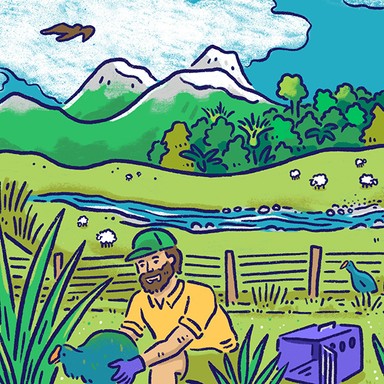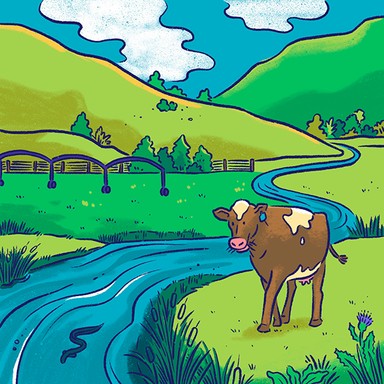
Greater Wellington Regional Council

Environment and biodiversity
Protecting the environment and managing natural resources is a key responsibility of regional councils. Regional councils are often also involved in pest control and resource management.

Environment and biodiversity
Protecting the environment and managing natural resources is a key responsibility of regional councils. Regional councils are often also involved in pest control and resource management.
Use statutory mechanisms like the Resource Management Act to protect significant natural areas. Embed policies at all levels of local government to give effect.
Implement the recommendations of the completed Whaitua processes to improve water quality and receiving ecosystems.
Effective environmental monitoring and enforcement.
Support reducing pollution thereby improving the quality of air, water, the environment and our health.
Carry out pest control led by national best practice, using guidelines and rules set by the Environmental Protection Authority and WorkSafe.
Incentivise our community to partner with pest control and planting projects. Team is best in regards to ensuring the best results.
Ensure and incentivise a greater emphasis on recycling waste, particularly waste that should and could be reused.
Incentivise commuters to use public transport, thus reducing the use of private vehicles unless it is necessary to do so.
Boost funding and action to control invasive weeds, predators and browsing animals and work to return kiwi and kākāpō to Te Upoko o te Ika.
Uphold Māori customary rights in Te Taiao, devolve power and provide resources to mana whenua for environmental work.
Provide more funding, resources and opportunities to community groups restoring our urban and regional waterways and ecosystems.
Ensure that regional council's biodiversity work is integrated with climate resilience work.
Enhance the role of regional parks as refuges for native plants and wildlife as well as people.
Provide funding for more local projects, led by community groups.
Build a comprehensive region-wide environmental monitoring system which is consistent across the entire region and easy to understand.
Support all the volunteer-run predator free programmes in the region.
Elevate the importance of trees around the region, supporting those who already work to protect them through programmes like QE11 Trust.
Reduce our environmental footprint through landfill diversion and smart recycling.
Create new reserves to support biodiversity and improve our region's natural resilience, as well as protecting existing ones.
Roll out successful Predator Free New Zealand initiatives across the region.
Support for Predator Free 2050 and new biodiversity sanctuary areas. Greater emphasis on ungulate control – goats, pigs, deer.
Urban streams: new approach to cleaning up our urban streams – eliminating sewage discharges and industrial waste going into our streams.
Enforcement and compliance: more funding for environment education, monitoring and compliance enforcement.
Boost funding and action to control invasive weeds, predators and browsing animals. Return kiwi and kākāpō to Te Upoko o te Ika.
Uphold Māori customary rights in Te Taiao, devolve power and provide resources to mana whenua for environmental work.
Provide more funding, resources and opportunities to community groups restoring our urban and regional waterways and ecosystems.
Commit to extend 'predator-free Wellington' project to 'predator-free Greater Wellington Region by 2050' project including regional funding.
Commit to embed te ao Māori and Mātauranga Māori and Te Tiriti o Waitangi into Council and apply it to all environment and biodiversity policies.
Commit shift from manual to remote sensing, digital monitoring and real time, web-based monitoring and reporting on environmental indicators.
Use statutory mechanisms like the Resource Management Act to protect significant natural areas. Embed policies at all levels of local government to give effect.
Implement the recommendations of the completed Whaitua processes to improve water quality and receiving ecosystems.
Effective environmental monitoring and enforcement.
Support reducing pollution thereby improving the quality of air, water, the environment and our health.
Carry out pest control led by national best practice, using guidelines and rules set by the Environmental Protection Authority and WorkSafe.
Incentivise our community to partner with pest control and planting projects. Team is best in regards to ensuring the best results.
Ensure and incentivise a greater emphasis on recycling waste, particularly waste that should and could be reused.
Incentivise commuters to use public transport, thus reducing the use of private vehicles unless it is necessary to do so.
Boost funding and action to control invasive weeds, predators and browsing animals and work to return kiwi and kākāpō to Te Upoko o te Ika.
Uphold Māori customary rights in Te Taiao, devolve power and provide resources to mana whenua for environmental work.
Provide more funding, resources and opportunities to community groups restoring our urban and regional waterways and ecosystems.
Ensure that regional council's biodiversity work is integrated with climate resilience work.
Enhance the role of regional parks as refuges for native plants and wildlife as well as people.
Provide funding for more local projects, led by community groups.
Build a comprehensive region-wide environmental monitoring system which is consistent across the entire region and easy to understand.
Support all the volunteer-run predator free programmes in the region.
Elevate the importance of trees around the region, supporting those who already work to protect them through programmes like QE11 Trust.
Reduce our environmental footprint through landfill diversion and smart recycling.
Create new reserves to support biodiversity and improve our region's natural resilience, as well as protecting existing ones.
Roll out successful Predator Free New Zealand initiatives across the region.
Support for Predator Free 2050 and new biodiversity sanctuary areas. Greater emphasis on ungulate control – goats, pigs, deer.
Urban streams: new approach to cleaning up our urban streams – eliminating sewage discharges and industrial waste going into our streams.
Enforcement and compliance: more funding for environment education, monitoring and compliance enforcement.
Boost funding and action to control invasive weeds, predators and browsing animals. Return kiwi and kākāpō to Te Upoko o te Ika.
Uphold Māori customary rights in Te Taiao, devolve power and provide resources to mana whenua for environmental work.
Provide more funding, resources and opportunities to community groups restoring our urban and regional waterways and ecosystems.
Commit to extend 'predator-free Wellington' project to 'predator-free Greater Wellington Region by 2050' project including regional funding.
Commit to embed te ao Māori and Mātauranga Māori and Te Tiriti o Waitangi into Council and apply it to all environment and biodiversity policies.
Commit shift from manual to remote sensing, digital monitoring and real time, web-based monitoring and reporting on environmental indicators.
Mayor
Compare the mayoral candidates in your area
Local council
Compare the candidates for your city or district council
Regional council
Compare the candidates for your regional council
Local board
Compare the candidates for your local or community board






